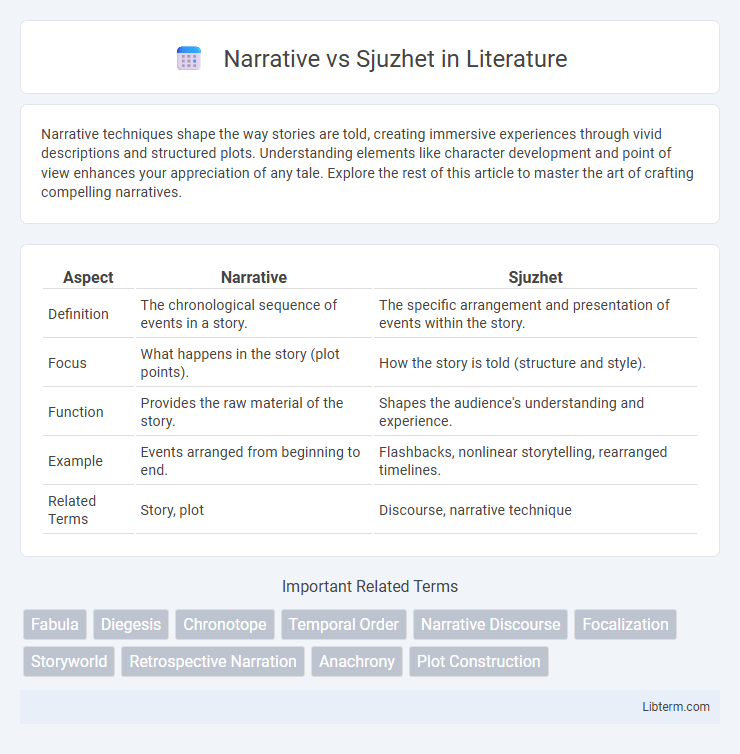Narrative techniques shape the way stories are told, creating immersive experiences through vivid descriptions and structured plots. Understanding elements like character development and point of view enhances your appreciation of any tale. Explore the rest of this article to master the art of crafting compelling narratives.
Table of Comparison
| Aspect | Narrative | Sjuzhet |
|---|---|---|
| Definition | The chronological sequence of events in a story. | The specific arrangement and presentation of events within the story. |
| Focus | What happens in the story (plot points). | How the story is told (structure and style). |
| Function | Provides the raw material of the story. | Shapes the audience's understanding and experience. |
| Example | Events arranged from beginning to end. | Flashbacks, nonlinear storytelling, rearranged timelines. |
| Related Terms | Story, plot | Discourse, narrative technique |
Understanding Narrative and Sjuzhet
Understanding narrative involves grasping the overall story or plot events in their chronological order, while sjuzhet refers to the specific way these events are presented or structured within a text. Narrative encompasses the raw content of the story, including characters, settings, and actions. Sjuzhet manipulates narrative elements through techniques like flashbacks, foreshadowing, and non-linear storytelling to influence the audience's perception and engagement.
Defining Narrative: Structure and Significance
Narrative encompasses the overarching structure and sequence of events within a story, serving as the framework that guides audience understanding and engagement. It integrates key components such as plot, characters, setting, and thematic elements to convey meaning and evoke emotional responses. Recognizing narrative significance allows for deeper interpretation of storytelling techniques and their impact on cultural and psychological contexts.
What is Sjuzhet? Key Concepts Explained
Sjuzhet refers to the specific arrangement and presentation of events within a story, emphasizing the order and structure through which the narrative is revealed to the audience. It contrasts with the fabula, which is the raw chronological sequence of events, by focusing on how the story is told rather than what happens. Key concepts of sjuzhet include manipulation of time, perspective, and causality, enabling storytellers to create suspense, thematic depth, and emotional impact through non-linear storytelling techniques.
Narrative vs Sjuzhet: Core Differences
Narrative refers to the chronological sequence of events in a story, while sjuzhet denotes the specific arrangement or presentation of those events to the audience. The core difference lies in narrative representing the raw timeline, whereas sjuzhet manipulates time and structure for thematic or emotional effect. Understanding this distinction is crucial in literary analysis, as it highlights how storytelling techniques influence perception and meaning.
The Role of Chronology in Narrative and Sjuzhet
Narrative and sjuzhet differ primarily in their treatment of chronology, with narrative presenting events in their natural, chronological order, while sjuzhet rearranges events deliberately for thematic or emotional effect. The role of chronology in narrative ensures a straightforward temporal progression that aids in understanding cause and effect, whereas sjuzhet manipulates time to emphasize specific plot points or character development. This manipulation of event order in sjuzhet creates a layered storytelling structure that challenges readers to piece together the timeline and uncover deeper meanings within the text.
Techniques of Sjuzhet in Storytelling
Sjuzhet techniques in storytelling manipulate the chronological sequence of events to enhance narrative impact, employing methods such as flashbacks, flashforwards, and non-linear timelines. These techniques allow storytellers to control the release of information, creating suspense, deepening character development, and enriching thematic complexity. By restructuring the narrative flow, sjuzhet transforms the raw story (fabula) into a compelling and engaging experience for the audience.
Narrative Order: Story vs Plot
Narrative order distinguishes between story (fabula) and plot (sjuzhet) by organizing events either chronologically or non-linearly to influence audience perception. Story refers to the raw chronological sequence of events, while plot manipulates this sequence through flashbacks, foreshadowing, or parallel timelines to highlight cause and effect or thematic emphasis. Understanding narrative order enhances interpretation of how time, causality, and character development drive the overall narrative structure.
How Sjuzhet Shapes Reader Perception
Sjuzhet, as the structured arrangement of narrative events, fundamentally shapes reader perception by controlling the timing and order in which information is revealed. This manipulation of sequence influences emotional engagement, suspense, and thematic emphasis, guiding readers to interpret the story through a crafted lens. By strategically altering cause and effect, sjuzhet transforms raw narrative material into a compelling and meaningful experience.
Examples of Narrative and Sjuzhet in Literature
Narrative and sjuzhet differ in how a story is presented versus its chronological events, with narrative referring to the structured account as experienced by the reader, and sjuzhet being the raw chronological sequence. For example, in Joseph Conrad's "Heart of Darkness," the narrative employs a framed story with nonlinear flashbacks, while the sjuzhet is the linear journey up the Congo River. Another example is Faulkner's "The Sound and the Fury," where fragmented narrative perspectives contrast with the sjuzhet of the Compson family's decline in chronological order.
Importance of Narrative and Sjuzhet in Modern Writing
Narrative and sjuzhet are essential elements in modern writing, shaping the way stories are structured and perceived by readers. Narrative refers to the chronological sequence of events, while sjuzhet denotes the way these events are presented or arranged to create a particular effect or meaning. Emphasizing the importance of both narrative and sjuzhet enhances storytelling by enabling writers to manipulate time, perspective, and information flow, thereby enriching the reader's engagement and emotional response.
Narrative Infographic

 libterm.com
libterm.com